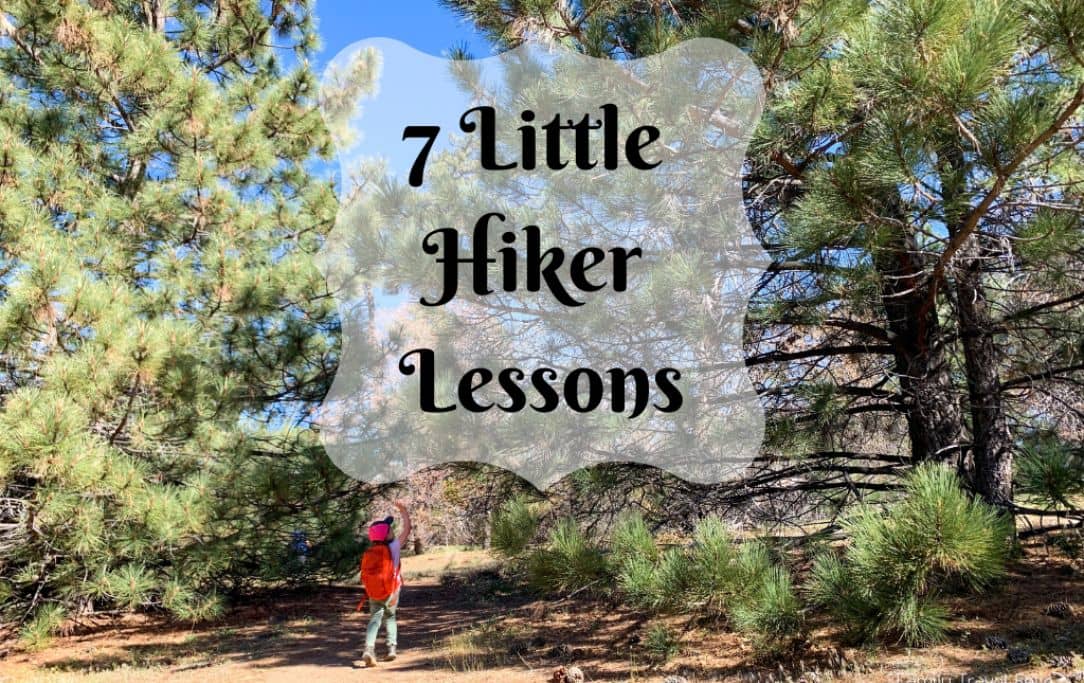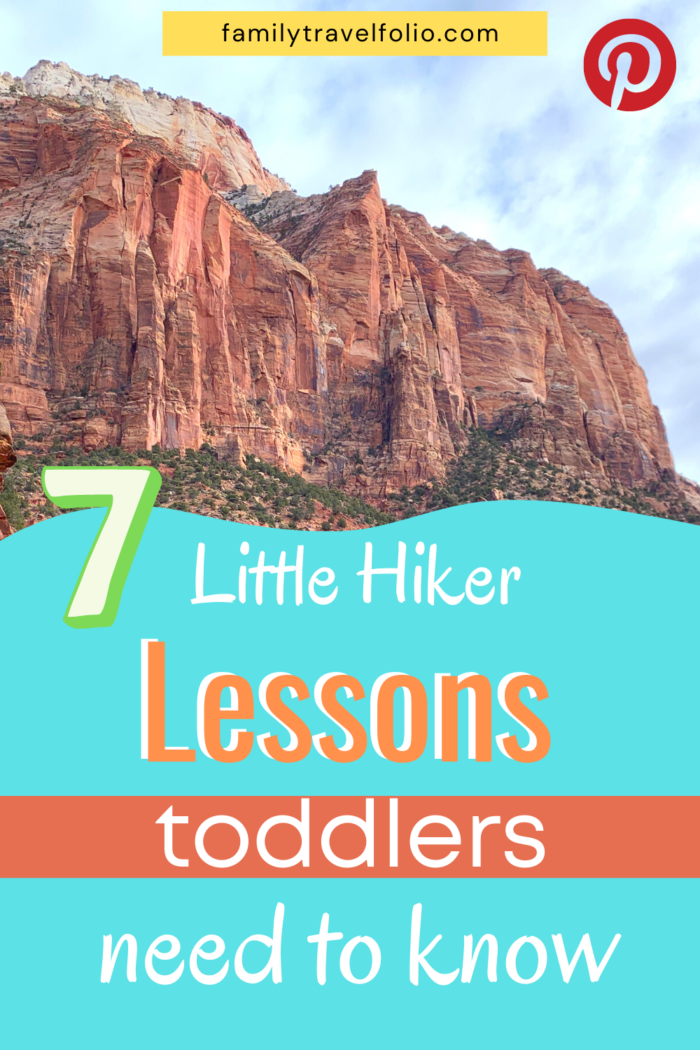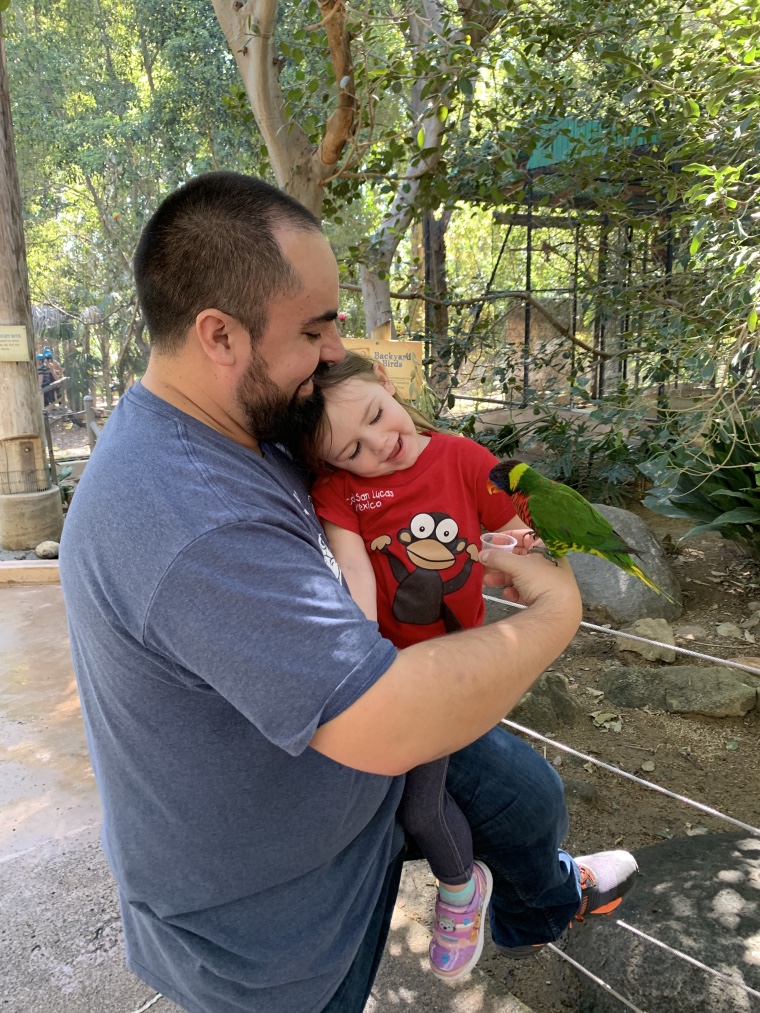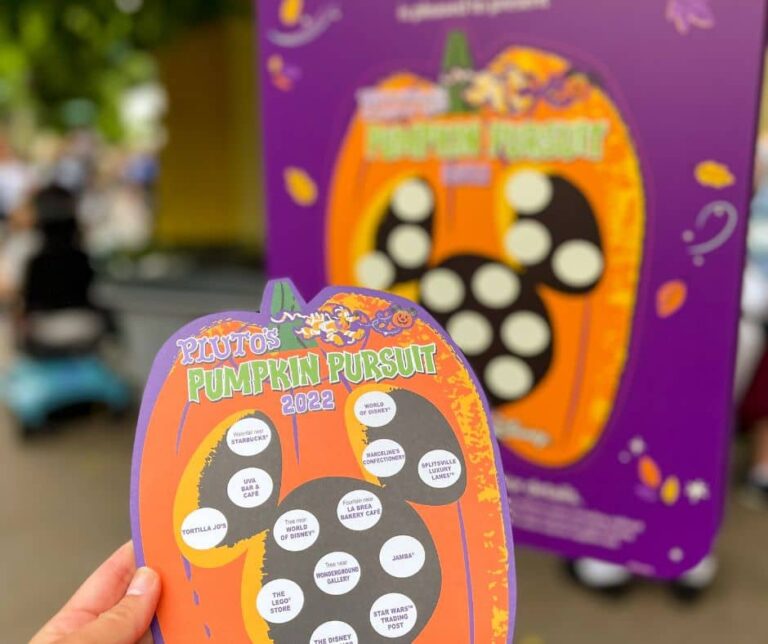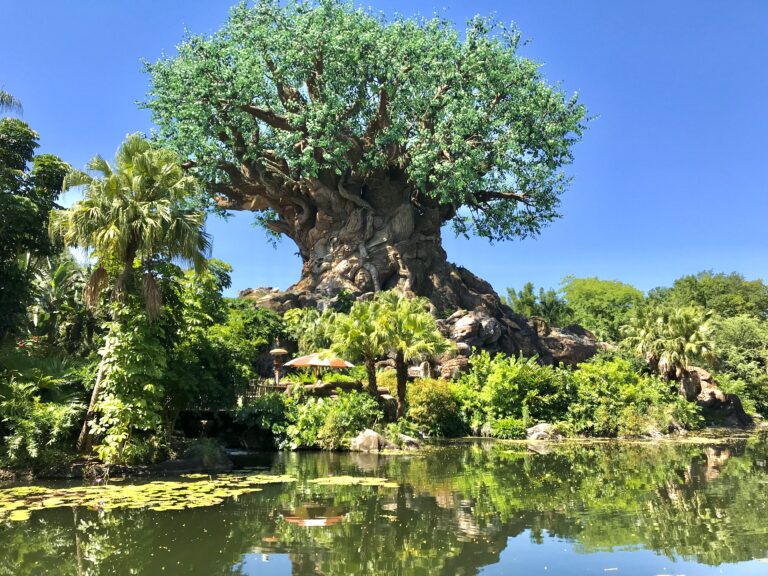Hiking with Kids: 7 Lessons Kids Need to Know
There are Affiliate Links on this Page which may result in compensation for Family Travel Folio at no additional cost to you. Please read our Disclosure Policy for more information.
Hiking with Kids Tips
Hiking with kids is one of the most rewarding and wholesome activities you can do as a family. If you are already set to go hiking with your kids, go ahead and skip to our Little Hiker Lessons below.
If you are not quite confident in hiking with your kids yet, don’t worry: you’re not alone, and we can help.
There are many families that don’t go on hikes together, and there are multiple reasons why. Here are the top 3 common reasons I’ve heard:
Top 3 Reasons not to Hike with Kids
- I am waiting until they’re older so we can go on hikes without worrying as much about safety
- The kids whine and complain that they want to go home, It’s not worth the effort
- Too much gear is needed for hiking with babies (bottles, diapers, wipes, snacks, a hiking carrier, etc.)
Maybe you have other questions or concerns as well. If so, please feel free to message me on Instagram.
After all, if you’re reading this post then you are either someone who already hikes with kids (and can appreciate the worries of those first starting out), or you want to be better about going on family hikes and just aren’t sure how to make it an easy & fun adventure for everyone.
Don’t worry, I’ve got you covered. We have many common questions answered in our Best Family Adventure post covering why you should hike, how old kids should be when they start hiking, how far little ones can hike, hiking gear you should have when hiking with babies, toddlers, and young kids, and more.
“Rooooaaarrrr” Munchkin echoed in the desert on top of a rock she had climbed. Joshua Tree National Park was her stage. She danced, she sang, she roared into the wind like a lion. It was so great to let her imagination run wild as we explored. But then…she wanted to play hide and seek…not the best game when she’s running up ahead and hiding where we can’t see her. Some games matched the environment, and others did not. It was up to us as parents to help her understand why we couldn’t play a certain way when hiking without crushing her adventurous spirit and ruining her fun.” Munchkin echoed in the desert on top of a rock she had climbed. Joshua Tree National Park was her stage. She danced, she sang, she roared into the wind like a lion. It was so great to let her imagination run wild as we explored. But then…she wanted to play hide and seek…not the best game when she’s running up ahead and hiding where we can’t see her. Some games matched the environment, and others did not. It was up to us as parents to help her understand why we couldn’t play a certain way when hiking without crushing her adventurous spirit and ruining her fun.
This post will specifically dive into the first 6 lessons our little hikers need to know. It should give you the confidence needed to start them off on the “right foot” so to speak as they are guided into great hikers that understand the basics of hiking safety.
This does not take the place of hiking safety tips such as first aid or navigation. It is not trail safety for adults. It is not all-inclusive. It is, however, a good tool kit on how to start talking about trail safety with your little ones, especially those toddlers and little kids just starting out walking stretches of the trails on their own.
You’ll walk away with:
- Confidence in leading your little one on various trails
- Actionable tips on how to talk about basic trail safety in a way toddlers and little kids will understand
- A foundational knowledge to teach your little ones, so they can build up to learning first aid, navigation, planning, and Leave No Trace principles as they grow older
If you start now while they’re young, it will be a natural progression of knowledge and understanding. They will grow up with a connection of family time and hiking, a respect for nature, and a healthy sense of adventure.
So let’s dive into what we need them to learn.
Little Hiker Lessons
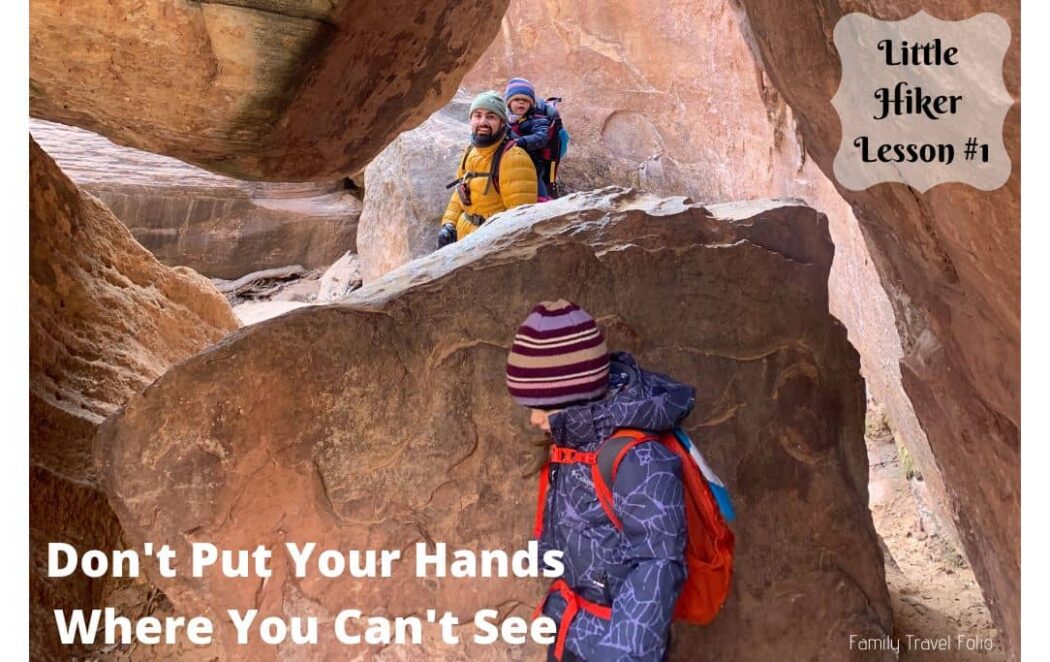
1. Don’t put your hands where you can’t see.
Little ones love to get into everything. It’s easy to get wrapped up in climbing rocks and exploring, but you never know what might be on top of that rock. A reptile may be soaking up the sun, or there might be some other kind of plant or animal your hand has no business being by.
Teach your little ones to get in the habit of only putting their hands where they can see. If they are too young for full communication, make sure to dialogue about what you are doing as you help them explore:
“Hold on, let’s check on top of this rock first. No animals? OK, put your hand here, your foot here…good job!”
The more you talk about what you are doing for safety checks yourself, the more they pick it up and understand as time goes on.
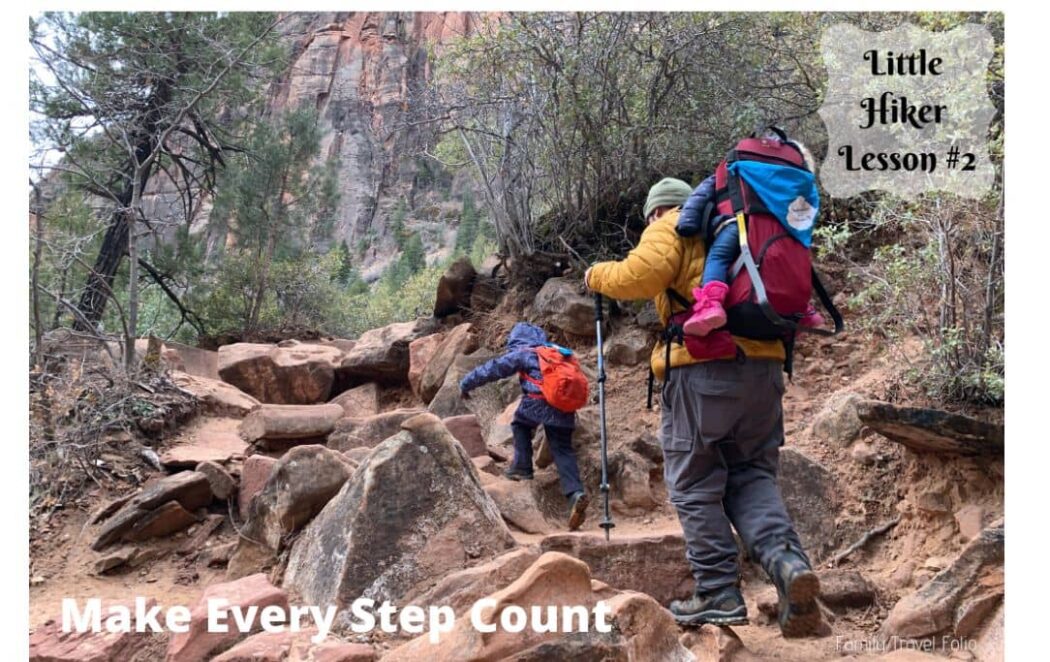
2. Make every step count.
This is another way of saying watch your step. Teach them as toddlers how to place their feet on sturdy spots (i.e. not on wobbly rocks or piles of leaves/substrate). The more they are exposed to this type of conversation and guidance, the faster they will pick it up themselves.
It has been amazing watching our oldest figure out how to adjust where she places her feet and how to walk over uneven terrain. We started hiking with her as a baby and viewing the different stages of awareness and walking in the great outdoors- nothing makes my heart happier (…except maybe Disneyland).
You get that moment of pride and the realization that “she gets it!” which is a win for everyone.
Just remember, once they learn how to walk on hiking trails, doesn’t mean they still don’t need a hand or extra guidance now and then.
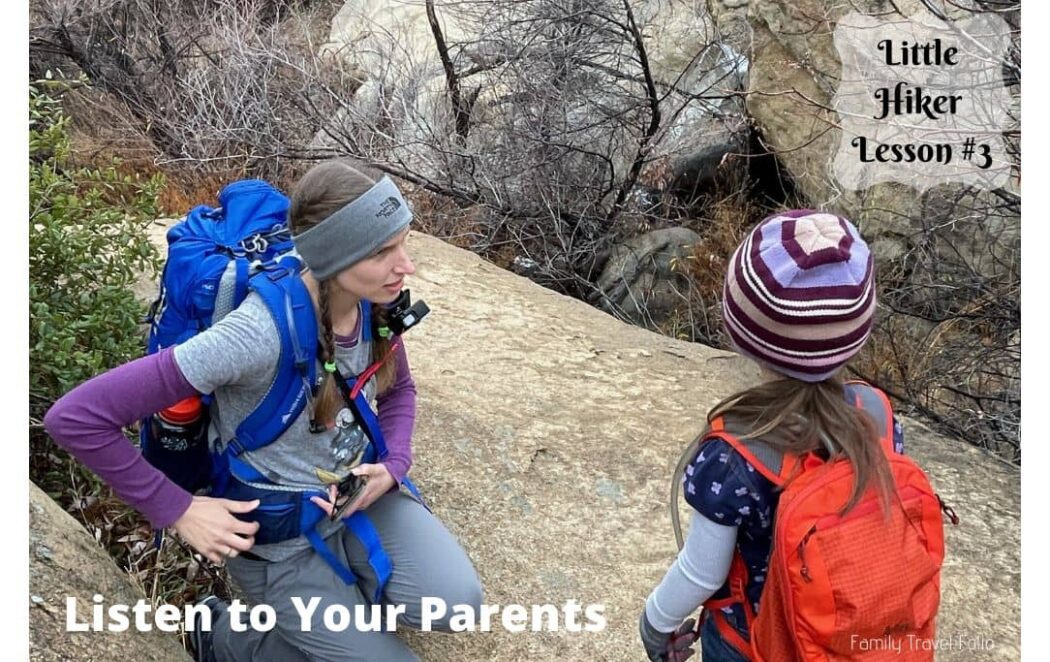
3. Listen to your parents.
It may seem obvious, but little ones love to push boundaries. At home it may be a bit more of a test on if you’re serious or not…that doesn’t fly when you’re on a mountain trail with a drop off on one side, or if there’s poison oak, or if there’s an animal up ahead.
When I say stop, you stop. Period. End of Story. You can’t do that, we go home (or you go in the carrier, or whatever other result they want to avoid).
Then…you follow through with it.
I don’t care if that toddler goes into the carrier crying “I want to walk!” You had your chance. You didn’t listen. You go in the carrier now.
They may be a bit too young to fully understand, but the more consistency you show, the more they understand cause and effect.
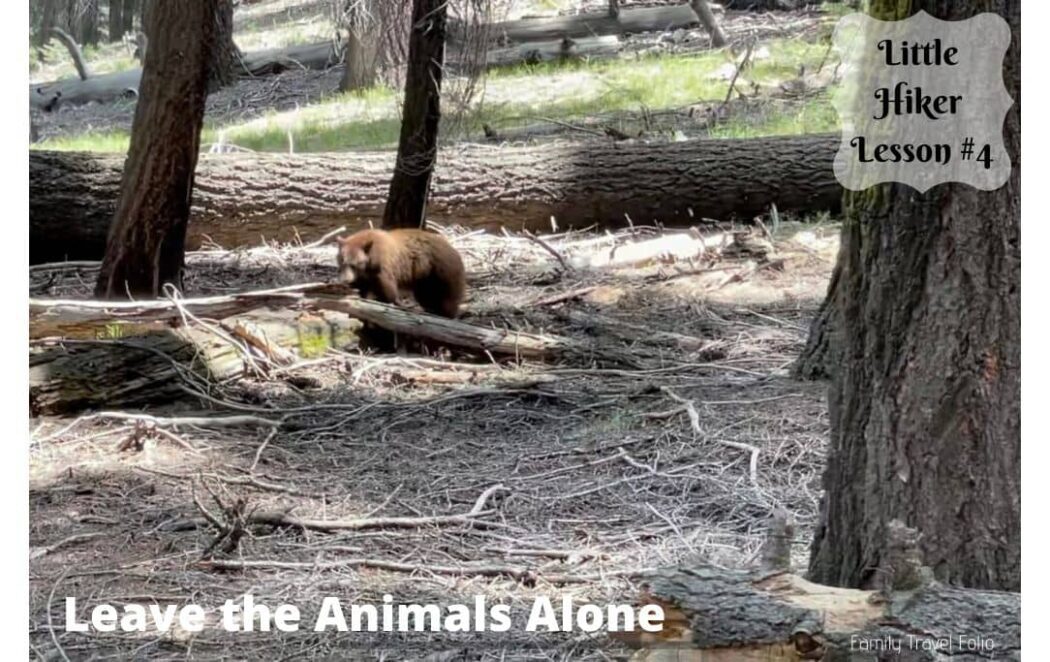
4. Leave the animals alone.
We are guests in the animal’s home. Not the other way around. Some animals are more dangerous than others (rattlesnakes, bears, etc.), but you still don’t want to bother any kind of animal.
If you see an animal, you can definitely get excited and point it out, but you don’t want to rush up to it or pick it up.
A good thing to tell your kids is to stop and then tell you whenever they see an animal. It will be a fun game for them to stop and point out animal observations, but it also gives you a moment to assess the situation.
Here are some questions to ask when you find an animal on a hike:
- What kind of animal is it?
- Does it seem agitated by your presence, or calm and non-interested?
- Are you at a 1) safe and 2) respectful distance?
- Do you need to stay still and wait or back away?
Depending on what the animal is, you might need to have your kid back up slowly and calmly and have the whole group back away, or it might be better to freeze, stay still, and wait for the animal to pass.
We ran into a baby rattlesnake on one hike- thank goodness our munchkin (then 1-year-old) was asleep in the carrier. My husband, sister, and I stopped, let it cross the trail, and then just kept going once the baby rattlesnake was a safe distance away. It wasn’t bothering us and we didn’t do anything to bother it.
Ways to Respect Animals When Hiking:
- Keep your distance
- Do not feed the animals
- Do not yell or shout (unless you are trying to alert bears to your presence for safety)
- Do not run
- Do not pick up animals
- Respect their environment
I can’t tell you how many times I see an agitated sea lion at La Jolla Cove because tourists are trying to get within inches for a photo. Use the zoom on your camera, please. Get creative with your photo where you do not purposely go closer to the animal, especially if it’s showing signs of agitation.
Leave No Trace has a great “Rule of Thumb” for checking your animal distance: If you can hold up your thumb and cover the animal from your view with it while closing one eye, then you are a respectful distance away.
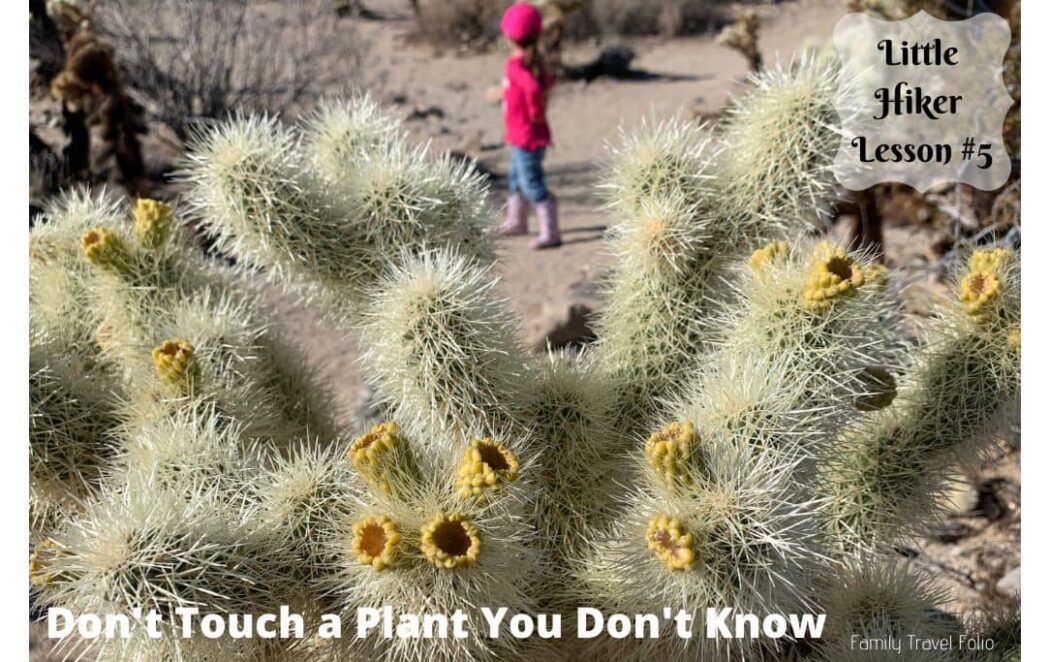
5. Don’t touch a plant you don’t know.
There are many plant species out there that should not be touched. Whether they are poisonous, pokey, or just fragile, we are guests in their home too and need to respect that.
Plants may not be like humans and animals, but they are living things that can easily be injured by human presence and interference.
Teach your little hikers that plants deserve to be treated nicely too. Animals may need those plants for food or shelter. Some plants may give you an itchy red rash. Others may have spikes or thorns that will hurt when you touch them.
Little Hikers will most likely be too young to remember which plant is which, or fully understand consequences. This rule can start out general (don’t touch any plants) so it’s all-encompassing and can be understood by our youngest hikers. As they get older, they may learn which plant is which, what you may be ok to touch, and what you definitely need to leave alone.
We often run into different types of cacti and quite a few trails in Southern California have poison oak. After we taught our munchkin about poison oak and why not to touch it, she was too nervous to walk through the brush. We had to tell her we would let her know when we see a plant she can’t touch so she would keep walking! She gets excited when she sees a cactus because that’s an obvious plant she remembers and knows to avoid.
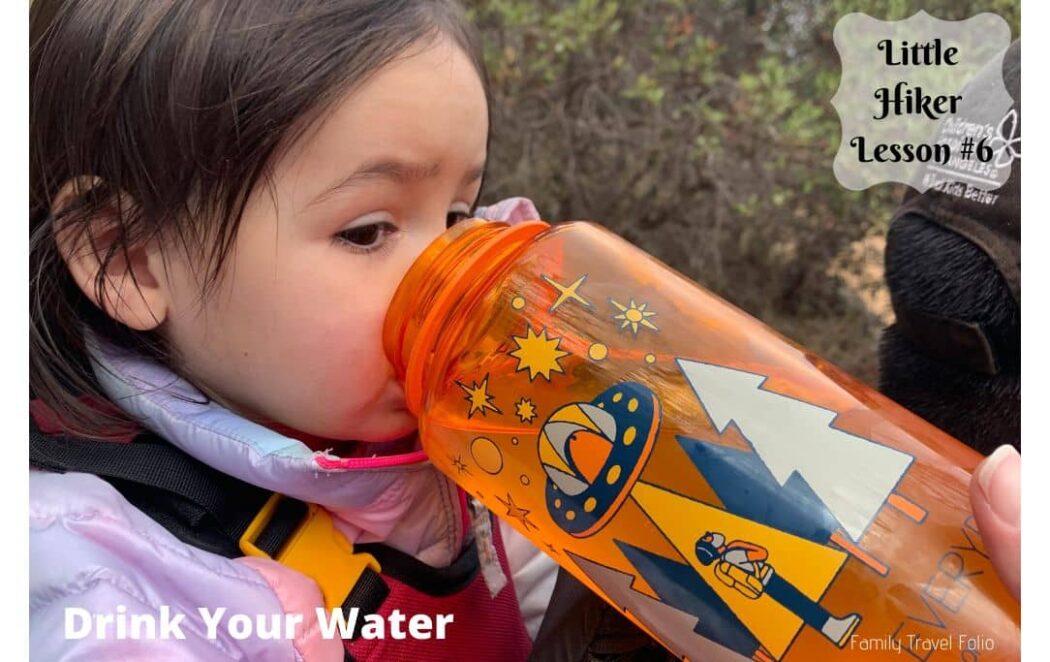
6. Drink your water.
Stay hydrated. It’s easy for adults to go longer without water (even longer than they should…), so it can be overlooked. Parents also may be tempted to have kids not drink a lot of water so they don’t need to go potty when on the trail. Never withhold water- you don’t want dehydration or any other medical issues to occur. Be aware of where the bathrooms are, brush up on how to go potty responsibly, and maybe plan for some shorter hikes while you figure out your munchkin’s limits and a good routine of dealing with the situation.
We have both rushed back to the bathrooms and popped a squat a good distance away from the trail and water sources. You can find more info about responsible waste disposal here at the Leave No Trace website.
How do you get kids to drink enough water when hiking?
4 methods for kids to drink more water when hiking:
- Their own water bottle
- Your water bottle
- Reusable straw
- Water bladder
Their Own Water Bottle: Kids love their own items. It makes them feel special, more grown up. They can choose their own color or design, and put stickers on the water bottle. This is a great choice for kids, but beware you will probably end up carrying it still.
Your Water Bottle: Right when you think they are good with their own water bottle, they suddenly decide that mommy or daddy’s water bottle is better than what they have. Daddy usually has electrolytes in his, so they like it because of the flavor. My water bottle, well, they always want what I have. We have a couple of mommy’s girls.
Reusable Straw: If they do choose your water bottle which may have a wider mouth to it, a reusable straw is a great solution. It is something fun, new, and exciting to use, plus it keeps them from spilling all of your water. It also works great for the munchkin in the carrier to drink water while staying in the carrier without as much hassle.
Water Bladder: This is my favorite because it’s easier to drink while walking. If I only drink water when I stop, I do not drink enough water. We have this amazing kid’s hiking backpack from REI that includes a kid-size water bladder. Check out this comparable Kid’s Hiking Backpack on Amazon. Our munchkin loves it, and she shares very well with her sister (for now…). It works as a giant straw, and she can easily carry her own water.
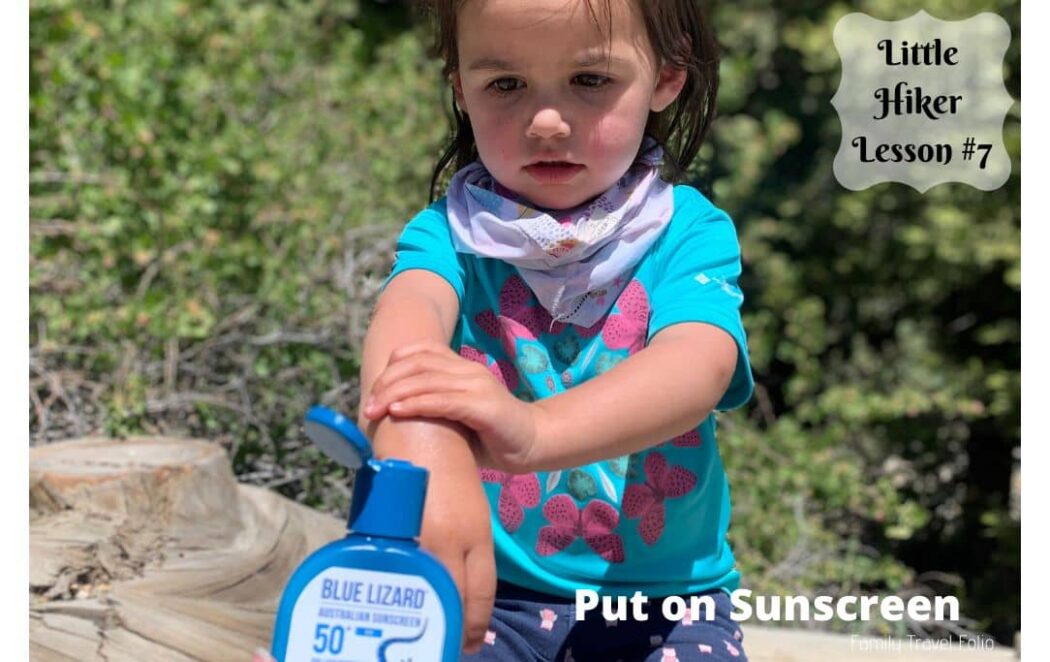
7. Put on Sunscreen.
I can’t tell you how many times our kids fight us over sunscreen. It’s not even that they don’t want it on- sometimes, it’s just that they want to do it themselves.
Either way, make sure the importance of protecting themselves from the elements- especially the sun- is communicated. We just tries out this non-scented Blue Lizard sunscreen and the girls loved how the bottle changes color in the light (harmful UV rays). We also received this amazing All Good sunscreen butter from our Nomadik subscription box, and they were fighting over it to reapply to their cheeks, nose, and ears.



The point is- don’t take no for an answer, but if it’s a fight to make sure they have sunscreen on, then maybe try a different brand or container. Something new and different always sparks an interest.
Hats and a carrier sunshade are important too, but sunscreen is the main protection. How do your little ones do with sunscreen?
Concerns About Hiking with Kids
Let’s revisit those 3 concerns about hiking with kids:
I am waiting until they’re older so we can go on hikes without worrying as much about safety
Teach them hiking safety– it’s easy to start with these 6 lessons even when they’re toddlers. Also, pick the right trails. If you’re worried about them rolling down the edge of the mountain, choose a trail with a lower elevation. If you’re worried about being able to carry them most of the way in a carrier on your back, choose a shorter trail and work your way up.
The kids whine and complain that they want to go home, It’s not worth the effort
Sign up for our newsletter for notification when our “Little Hiker Motivation” post goes live. I hinted at them on Instagram, but there’s so much to say on how to implement these 15 tips- with examples of how we use them ourselves!
Too much gear is needed for hiking with babies (bottles, diapers, wipes, snacks, a hiking carrier, etc.)
Many trails are by bathrooms with full plumbing, diaper changing stations, and trash cans. A lot of trails also have benches if you need to sit for breast or bottle feeding. Stay closer to the trails by the city to increase the chances of comfort amenities, and look it up ahead of time. AllTrails has great info on trail details.
If you’re looking for tips on how to take care of these details when in the middle of nowhere, then check out the section on what you need when hiking with kids in our Best Family Adventure post mentioned earlier.
A side tip: we use a stuff bag to carry 2-3 diapers, wipes, doggy poop bags (for the dirty diapers), and our sunscreen. Doesn’t take up much space and isn’t very heavy. If you’re going to be gone all day, or are worried about not having enough diapers & wipes, carry some extra in your car. A lot of easy family friendly hikes can be done in 1-2 hours, so you may not need as much as you think.
Next Steps to Hiking with Kids
Alright, I hope this helped break things down for you and instill confidence in your hiking approach with your little ones. Let’s get you out on the trail.
It’s our goal to inspire and help families go on adventures so they can make amazing memories, learn about the world, and spend quality time together.

